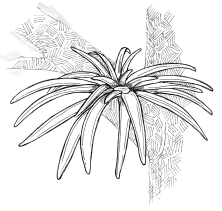Anchored in one place, plants can’t travel to search for
life-sustaining water. Plants growing in regions where water is scarce or available only
during a brief rainy season have adopted various strategies for survival. Let’s
voyage into a desert, and look at the various strategies for survival in an environment
where water is in short supply.Think of a desert,
and most likely what first comes to mind is the cactus. Cacti are among the most
drought-resistant plants. What strategies have cacti evolved to endure desert conditions?
Here are a few characteristics common to many cactus species:
- Succulent stems allow cacti to store water. The barrel
cactus has an accordian-like stem that allows the cactus to swell as roots take in water
during a rainy spell, then shrink as this moisture is used up.
- The spines on a cactus perform a number of important
functions. They help shade the plant from intense sun, helping to cool the surface. And,
if you’ve ever bumped into a cactus by mistake, you know that they also serve as
protection.
- An extensive, shallow root system allows cacti to take
advantage of even the lightest rainfall.
- During the hot, dry summer, many desert plants drop their
leaves and go dormant. Cactus spines are modified leaves; photosynthesis takes place in
the stem and can continue throughout the summer. With no leaves, the surface area exposed
to the sun and drying winds is reduced, which in turn reduces water loss from
transpiration.
- Cacti have a waxy cuticle layer that helps seal in
moisture.
Here are some other ways desert plants cope with a
scarcity of water.
- The desert lily’s bulbs are found at a depth of
12-18". The plant can lie dormant for years until adequate water is available.
- Welwitschia, a desert gymnosperm, absorbs water from
the nighttime fog through its leaf stomata.
- The creosote bush has a far-ranging root system; roots may
reach 75 feet in length.
- Some plants complete their life cycles in months, or even
weeks. Desert sand verbena seeds germinate in the spring after the winter rains. They grow
quickly, bloom, and produce and scatter seeds, then die with the onset of summer heat. The
seeds are extremely durable and drought-resistant, and may lay dormant for years until
conditions favorable for germination return. Plants that bloom for a brief time in the
spring are often referred to as "ephemerals."
Scarcity of water isn’t restricted to desert
environments. Even some rainforest plants are challenged to meet their water needs. We
mentioned in the section above that certain rainforest plants called epiphytes grow up in
the branches of the canopy. Lacking the ability to draw water from the soil, they have
evolved other strategies:
- Orchids have aerial roots that can absorb atmospheric water
vapor.
- Bromeliads grow in tree branches; their leaves grow in
cup-shaped rosettes which collect rainwater.
Bromeliad

Closer to the home front, let’s look at how these
principles might apply in the garden and landscape.
- As in the rainforest, water stress can occur in the most
unlikely of places. Are the plants near your foundation struggling? Is there by any chance
an overhanging eave that prevents rainwater from reaching those plants?
- Some trees have far-ranging root systems, able to go to
great lengths in search of water. Poplar trees, for example, have extensive root systems
and are notorious for damaging underground water and sewer lines in their search for
water.
With fresh water becoming more and more precious, many
gardeners are looking for landscaping alternatives their yards. Do you find yourself
watering your landscape plants almost every day in the summer? Are the gardens in your
community totally dependent on "imported" water? Are your water bills going
through the roof? Has your town issued bans on watering during periods of drought?
One solution to this landscape dilemma lies in a concept
called "xeriscape gardening." This is a fairly new term for an old
concept—taking your cues from nature and choosing plants that are well-adapted to
your particular climate, in this case a dry climate. There are thousands of plants that
will grow in dry regions with little or no supplemental watering. Gardeners
may, however, need to rethink their ideas of the "ideal" garden. Keep in mind
that the "English cottage garden" look is, well, adapted to England, where
summers are cool and rain is plentiful. Trying to grow this type of garden in
what are essentially desert conditions is not only frustrating, it wastes a valuable and
limited resource.

|
|
 Rainforest Cactus?
Not all cactus species are native to desert
environments. That familar holiday plant, the Christmas cactus (Schlumbergera buckleyi),
is the result of breeding efforts in the mid-1800s in London. The "parent"
plants are native to the rainforests of Brazil. And one type of prickly pear cactus (Opuntia
humifusa) ranges from Massachusetts to Montana, Florida to Texas. |
 Slow and Steady.
If you’ve ever grown a cactus as a
houseplant—especially a barrel type—you know that they are extremely
slow-growing. One of the consequences of this plant group’s remarkable adaptations to
withstanding the harsh conditions of the desert is a very slow growth rate. This makes
sense if you consider how the various adaptations to protect the plant from intense sun
and water scarcity also reduce its ability to photosynthesize. |
 Another Kind of Bloom.
You’ve probably seen a dull, powdery bluish-white
coating on various fruits, including plums, apples, and grapes. This natural surface wax,
called a "bloom, " is easily wiped off.
Other plants with a noticeable bloom include some
succulents and cacti; also the leaves of carnations and cabbage (especially red cabbage).
Though all plants have a cuticle layer, this visible
bloom occurs when the surface wax occurs in tiny "rodlets" that protrude from
the surface cells. Like all cuticles, the bloom helps conserve water by reducing
evaporation from surface tissues. The word glaucous is used to
describe plants with a visible waxy bloom. |

Car Wash Blues.
As is the case with any waxy substance, a plant’s
cuticle repels water. Because of this, water often "beads up" on
leaves—like it does on a newly waxed car!
You may have heard the recommendation
to add a few drops of soap to homemade pesticide sprays. This soap acts as a
"spreader-sticker," helping the liquid form a continuous film over plant
surfaces, rather than beading up and dripping off like ordinary water would. |
|
|
|